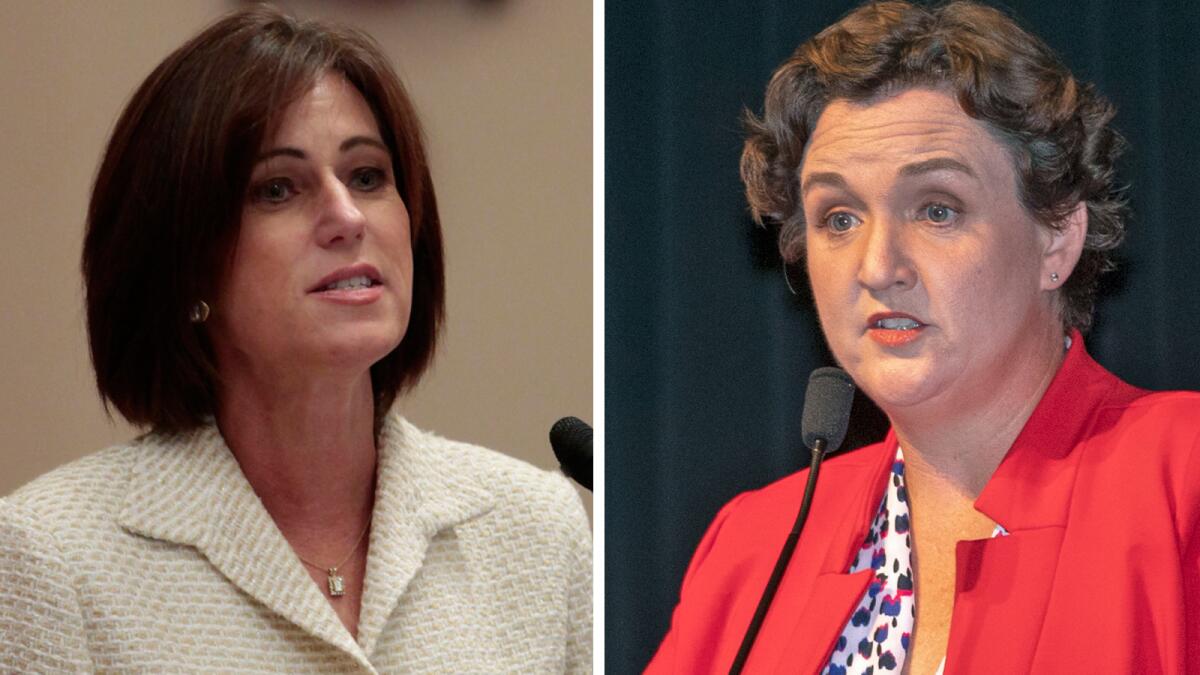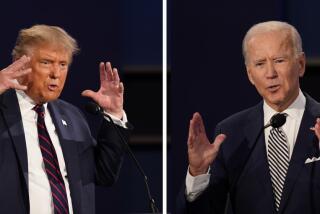Where’s Trump? He’s barely seen in Democrats’ attack ads in key SoCal House races; he’s missing in GOP spots too

Republican Reps. Mimi Walters of Laguna Beach and Steve Knight of Palmdale are both staunch allies of President Trump. But only Walters is getting trashed for it in Democratic attack ads.
One spot shows a wall of shelves crowded with two brands of beer: Donald Trump (“a unique blend of malted nonsense and flavorless hops”) and Mimi Walters (“A Flat Beer Company”).
“How often does Mimi Walters vote with Donald Trump?” a narrator sneers between refrains of “99 Bottles of Beer.” “Ninety-nine percent of the time.”
Yet, in the onslaught of Democratic ads that attack Knight, Trump is entirely absent.
One of the more brutal ads begins like a travel come-on, with a palm-shaded tropical beach, a waiter offering a drink. A ukulele and slide guitar play as the ad takes Knight to task for Hawaiian getaways he took at the expense of drugmakers whose tax breaks he backed.
The contrasting approaches reflect a split among Democrats trying to net 23 seats to seize control of the House in the Nov. 6 midterms: Should they ignore Trump or campaign against him?
Some Democrats see attacking Trump as essential in an election that will show whether Americans want Congress to put a check on the president. Others avoid Trump and focus on contrasts with specific GOP candidates. Which path they choose depends on a high-risk calculation of whether mentioning the president might backfire with even a sliver of voters in a close contest.

In Southern California, where four of the nation’s most competitive House races are raging at full bore, millions of television viewers are being inundated with 30-second campaign ads.
Never before have so many congressional campaigns and their supporters spent as much on TV advertising in the costly L.A media market. Candidates and their allies have already spent more than $27 million to book ad time during the final three weeks of the campaign.
Democrats are dominating the airwaves, thanks to record sums of money from anti-Trump donors.
Democratic challengers Katie Porter and Harley Rouda in Orange County and Katie Hill on the northern outskirts of L.A. have bought enormously expensive ad time on stations that broadcast far beyond their districts.
To target swing voters in their districts, they’re paying to send their ads across the entire TV market: L.A., Orange, San Bernardino and Riverside counties and beyond.
“It’s not really logical to spend that much of your money on television advertisements — unless you’ve got money to burn,” said Joseph Tuman, a professor of legal and communications studies at San Francisco State.
Republicans for the most part have limited advertising in California to less-costly cable channels. Many of the ads accuse Democrats of backing colossal tax hikes, an often effective tactic in conservative precincts of Orange County, Simi Valley and the high desert.
“We cannot afford Katie Porter,” a man identified as Jerry P. tells viewers in a Walters spot attacking her Democratic challenger in the state’s 45th Congressional District.
“She is just too liberal,” a woman named Brook B. adds.

One person missing from the Republican ads is Trump. The president lost to Hillary Clinton in nearly all of the Republican-held districts now targeted by Democrats in California, and voter hostility toward him is why many GOP seats are in jeopardy.
If Republicans do tout support for Trump’s agenda, they’ll more likely target reliable GOP voters — with mail, digital ads and robocalls — to ensure turnout. That way swing voters won’t get the same message.
“No need to broadcast that to the entire world,” said Ken Goldstein, a politics professor at the University of San Francisco.
On the Democratic side, Porter advisors see Trump’s unpopularity as the campaign’s driving force. “We need to make Mimi Walters and Donald Trump synonymous,” said Porter strategist Sean Clegg.
The upscale 45th Congressional District — including Laguna Hills, Mission Viejo, and Irvine — favored Clinton over Trump in 2016. Similar suburban districts with concentrations of college-educated white voters have turned strongly against Trump in special elections across the nation.
Porter’s ads fault Walters for supporting the Trump tax law that raised many Californians’ federal income taxes by capping deductions for state and local taxes. (Walters and her allies argue in their ads that the law reduced taxes for many middle-class families.)

One Porter spot also criticizes Walters for backing Trump’s moves to deny public money to Planned Parenthood.
Walters strategist Dave Gilliard said Porter was resorting to Trump themes because she’s too liberal for the district. “Her only option is to use guilt by association,” he said.
The other Democrat who has tied his rival to Trump is Gil Cisneros in the race to succeed retiring Republican Rep. Ed Royce in the 39th Congressional District, which includes Fullerton and Yorba Linda.
Cisneros has repeatedly faulted his Republican opponent, former Royce aide Young Kim, for backing Trump’s tax agenda.
“President Trump is not a popular figure, and a big part of Gil’s messaging is that he’s going to go to Washington to hold the president accountable,” said Cisneros campaign manager, Nic Jordan.
House Majority PAC has picked up the same theme. The super PAC closely tied to House Minority Leader Nancy Pelosi of San Francisco is running a spot that labels Kim the apprentice of a “celebrity TV president.”
“Young Kim’s audition went great,” a narrator says as an image of Kim is superimposed on mirrors in a stage dressing room. The ad ends with Kim at a boardroom table like the one in Trump’s reality TV show, “The Apprentice.”
(Kim, a former state assemblywoman, “has a proven track record of working across party lines,” said Gilliard, her spokesman.)
House Majority PAC has taken a different tack against Republican Rep. Dana Rohrabacher of Costa Mesa in the 48th Congressional District. It is airing a spot showing a dazed-looking Rohrabacher floating in an astronaut suit as the “Blue Danube” waltz plays.
“Earth to Dana,” mission control calls out as a rocket labeled “Russia” glides by, an allusion to his pro-Kremlin leanings. The incumbent believes homeowners should not have to sell to gay people, a narrator says, and schools would be safer if students were trained to shoot guns. “Dana, do you copy?” mission control asks. “I think we’ve lost him completely.”

Strategists for both parties agree there are better ways to attract votes than talking about the president.
“Trump is already baked into voter attitudes,” said Rob Stutzman, a top Republican consultant in Sacramento. “They don’t need to advertise about the president.”
Anger among the president’s detractors is so intense that campaigns “don’t need to talk about Trump to get these voters wound up,” said Fred Register, a Democratic strategist in Pasadena. And in districts long held by the GOP, he said, Democrats must appeal to moderate Republicans who might resist the idea of a Democratic House takeover.
“It’s not like suddenly these places have been turned into flaming liberal districts,” Register said.
Whether they campaign hard against Trump or not, the Democrats are all casting themselves as centrists as they fend off accusations that they’re big spenders beholden to Pelosi.
Cisneros highlights his military service. Rouda, Rohrabacher’s Democratic challenger, markets himself as a businessman with a record of creating jobs.
And Hill, trying to oust Knight in a district that covers Simi Valley, Santa Clarita and the southern Antelope Valley, says in one of the most widely shown ads that she backs tax cuts and a secure border.
Hill strategist Bill Burton, when asked why her ads don’t mention Trump, said voters need to know where candidates stand on issues. “Voters care about healthcare, corruption in politics, and having a member of Congress who will put their district over their political party,” he said.
Like Walters, Knight has sided with Trump 99% of the time in his House votes, according to the statistical analysis website FiveThirtyEight. But in the 25th Congressional District, attacking him for his alignment with Trump could backfire.
The 25th is home to thousands of culturally conservative police officers and firefighters, active and retired, many of whom moved north from L.A. or Orange County for more affordable housing.
To Knight strategist Matt Rexroad, Hill’s use of a GOP talking point on immigration makes it clear she’s striving to avoid being seen as a partisan adversary of Trump.
“She’s trying to appear to be a Republican,” he said. “Secure border? What Democrat says that right now?”
Twitter: @finneganLAT
More to Read
Get the L.A. Times Politics newsletter
Deeply reported insights into legislation, politics and policy from Sacramento, Washington and beyond. In your inbox three times per week.
You may occasionally receive promotional content from the Los Angeles Times.






